An example search has returned 100 entries
kaipaip sei kuekau

n. sprawling herb, with erect flowering stems (collection: Gregory M. Plunkett #3237)
Example: Children take the inflorescence of this plant and use it to find and poke lizards hiding in the bush. For treatment of an unspecified spiritual sickness, chew 2, 2" pieces of the stem to get rid of the sickness, spitting the material on the hair and body of an ill person; use only 1 time.
bookmarkkakeakei

n. terrestrial fern growing in weedy patch with other herbs at edge of open forest heavily impacted by cyclone. Leaves dimorphic. (collection: Gregory M. Plunkett #3253)
Example: Used as a medicine to treat children who cannot walk. Rub smashed leaves on the knee of a child, "he will walk." For a child about 1 year old, rub the leaves on the knee and underside of the foot. This will make the child walk "easily and quickly." and will make the leg "lighter."
bookmarkkonambre
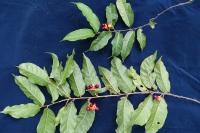
konuwak arwerew

Highfin coralgrouper
Example: Photo by David R / iNaturalist, License: CC BY-NC-SA 3.0 via Fishes of Australia
bookmarkkuanamporo

n. type of flowering plant (collection: Michael J. Balick #5131)
Example: Fruits edible when ripe. For dengue fever, take 1 bundle of leaves and stems, mash and place in pot with 2 L water, boil 30 minutes, drink warm. Drink 1 liter 1x day for 4-6 days depends on strength of dengue. "Sends" dengue out from your body.
bookmarkkwanei

kwankwanei

kwanmatwa
kind of yam, related to kawehae with a large mass of tubers that have red flesh and are sweet. It has the same type of flesh as that variety but the leaves differ in shape
Example: If a person loses some of his yams in the garden to various conditions, such as poor soil or disease, these two varieties will always continue to grow, being very hardy and resilient. This yam was originally from Iankahi but now the village is losing this variety. However, some people in Port Resolution still grow it
bookmarkkwareren-akwang

[nokukəpran] n. herb growing on large rock in open area, in middle of flowing stream. (collection: Gregory M. Plunkett #3117)
Example: People use this plant to treat heartburn and when they get indigestion. Take the leaf and wrap it with Ficus leaves ("manasus" unclear what species), chew them together and swallow the juice until the pain goes away.
bookmarkkwarwasei

n. type of flowering plant (collection: Michael J. Balick #5120)
Example: When parents go away to a feast or garden, children take a pile of soil 12 in. diameter, put this flower on top, surround wth some ashes and then hide in the house to wait to see if the dwarf spirit appears (Karwase Haruase). Sometimes the spirit will come and then scare the children. Ancestors used these spirits and games to teach children to stay together and not wander alone. As the dwarf spirit will take you.
bookmarkkwatavirua

n. type of flowering plant (collection: Michael J. Balick #5135)
Example: When this plant grows to 2m, peel bark and put it in salt water to rett the stem. To do this, tie the stems in bundles and cover the bundle with a stone in the sea. After one week, rett the stem by pulling out the strong fibers and discarding the rest. Dry the fibers, then make a grass skirt from this. The leaves can be crushed and used as a styptic for wounds to stop bleeding.
bookmarkkweiei

Striated Surgeonfish, Lined Bristletooth
Example: Photo by Mark Rosenstein / iNaturalist.org, License: CC BY-SA 3.0 via Fishes of Australia
bookmarkmafiji
makhum
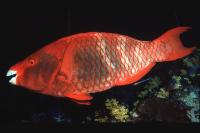
Red parrotfish
Example: Photo by J. E. Randall, License: CC BY-NC 3.0 via Fishes of Australia
bookmarkmanto billy
mar

Yellow Oriental Paper Wasp
Example: Photo by flecksy / iNaturalist, License: CC-BY-NC via inaturalist.org
bookmarknamap

n. type of flowering plant (collection: Michael J. Balick #5112)
Example: To make rain, take four branches, mixed with Zingiber zerumbet (5078). Leave for one week until it rots and smells bad. Move it to the land and it will rain. Leaf is used to stop lightning and thunder. Take four leaves mash, cut a forked stick of Natchy (5019) take outer bark off, put in fire to warm it, wrap with leaf, put in ffront of you in ground and when lightning is coming break off the fork and the thunder will stop. Children eat the fruits.
bookmarknape

n. type of flowering plant (collection: Michael J. Balick #5043)
Example: Branches used to make bow and arrow for hunting. Stem used for fence posts and houses. To treat a strong cough, take a branch of 20 leaves, toss in water, boil 10-20 minutes, drink warm liquid 2 cups a day for 1 week or until cough is gone.
bookmarknapoti sarariman

Yellow-striped sweetlips (male)
Example: Photo by Graham Edgar / Reef Life Survey. License: CC BY 3.0 via Fishes of Australia
bookmarknare

n. herb to 1.5 m tall, flowers white (collection: Michael J. Balick #4722)
Example: This plant is used to welcome people by weaving the leaves and flowers into a head lei, locally known as a Kuanari. If there are no flowers, people weave the leaves and use these to welcome visitors. This species is becoming an invasive in the area.
bookmarknauri

[newri] n. tree, 3 m tall (collection: Gregory M. Plunkett #2989)
Example: Fuel: Dry portions of this plant are used as firewood. Construction: The timber of this plant is used to createany part of a house. It is considered a strong wood. Medicine: This plant is used to treat muscle soreness. It can be prepared in tow ways. One way is to boil and branch of leaves and then bathe (“swim”) with the resulting water. Another way is to heat a branch over a fire and rub on sore area for approximately 1 minute, after showering.
bookmarknekaritang

[naka̤ri̤təŋ] n. tree, growing in disturbed forest/garden area. (collection: Gregory M. Plunkett #3107)
Example: Used to trap birds. Cut the stem of this plant and collect the sap. Take a small vine locally known as Nanupi, and roll the vine into a ball, infuse it with white latex which then turns brown, put it in a papaya or banana tree--when a bird comes to feed on the fruit of those trees, it gets stuck to the ball and can’t leave. This is good for harvesting small birds to be eaten.
bookmarknekaritang

n. tree, growing in disturbed forest/garden area. (collection: Gregory M. Plunkett #3107)
Example: Used to trap birds. Cut the stem of this plant and collect the sap. Take a small vine locally known as Nanupi, and roll the vine into a ball, infuse it with white latex which then turns brown, put it in a papaya or banana tree--when a bird comes to feed on the fruit of those trees, it gets stuck to the ball and can’t leave. This is good for harvesting small birds to be eaten.
bookmarknepar nepar

[napurnapur] n. small sapling, 1.5 m tall (collection: Gregory M. Plunkett #3029)
Example: Fuel: Firewood Construction: Used to construct posts for houses. Tools: Wood is used to fashion handles for axes. Hunting: Wood is used to make the limbs of a bow. It is not considered the most suitable wood for this purpose.
bookmarkneparum

n. vine, growing in disturbed forest/garden area. (collection: Gregory M. Plunkett #3103)
Example: Before there were many root crops such as taro and cassava, people would use the roots of this plant as a food, after roasting it in the fire. The roots are said to be very large and edible.
bookmarknewahu

n. type of flowering plant (collection: Michael J. Balick #5114)
Example: Weave bark fiber to make slings, grass skirt for ladies, hats and baskets. To do this, rett outer bark in sea for 1 week to rot everything but the fiber, take remaining fiber, dry in sun and use as a fiber for weaving.
bookmarknihpar

nipina

n. type of flowering plant (collection: Michael J. Balick #5015)
Example: Take 1 double handful of leaves, mix with dry coconut, roast in fire -- cover w/ banana leaf, tie up roast in fire for 5-10 min, take it down to the sea and the boys who have been circumcised 2 weeks before wash the sore with it. Dries up sore faster and wash skin and adds a fragrance to it. To treat strong fever, take knife and squeeze stem and put shavings on a leaf take 1 handful and mix with water and fill up a cup and pout into 1 bottle -- in morning and afternoon and consume 1 liter/day repeat for second day fever will do down in a few days.
bookmarkniras

nkafereng

nɨpɨn vi
oklen
pan

pawpawuk

Caper White
Example: Photo by givernykate / iNaturalist, License: CC-BY-NC via inaturalist.org
bookmarkpenesu
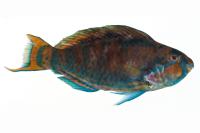
Highfin parrotfish
Example: Photo by Jeffrey T. Williams / Smithsonian Institution, License: CC BY-SA 3.0 via Fishes of Australia
bookmarkpeyeii pitew

Harry hotlips, blubberlip
Example: Photo by ANFC, License: CC BY-NC 3.0 via Fishes of Australia
bookmarkpirawa ~ firawa
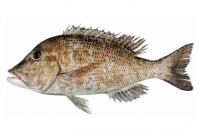
taopir-taopir
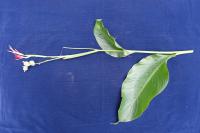
taupar taupar

n. type of flowering plant (collection: Michael J. Balick #5132)
Example: Flower for decorating things like at marriage, church, opening of new building like dispensary. Ancient people, when needed water, take stem, mash 4-6 pieces and squeeze into coconut shell and drink it. So squeeze the stems together after mashing them along their entire length with wood post. This can be used to collect water today when a person is in the forest and thirsty. Leaves wrap banana laplap. Put in saucepan boil 20 minutes, toss out water, take leaf off and eat laplap. Leaf folded not tied. People say its native to Vanuatu
bookmarkteara

n. type of flowering plant (collection: Michael J. Balick #5116)
Example: If a person gets cut while on reef, take leaves and burn them to an ash. Put this powder on the sore for one day to dry and heal cut. For constipation, take 1 handful bark, mash it, put with coconut water (one coconut’s worth), and drink a cup once. Don’t do other activites. This will clear bowel within a day. Very powerful.
bookmarktemian

n. type of flowering plant (collection: Michael J. Balick #5023)
Example: The wood can be used to make poled for cattle fences. Fruits are sweet and edible. They are also very juicy, and can satisfy thirst. Take bark off of the tree and scrape the green inner bark of tree off. Cover a boil with these pieces to reduce the size and help it heal. Apply once a day for three days.
bookmarktipurpai

yanar

Flathead grey mullet, sea mullet, grey mullet
Example: Photo by ANFC, License: CC BY-NC 3.0 via Fishes of Australia
bookmark









